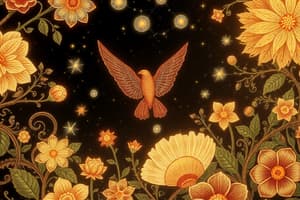Podcast
Questions and Answers
What distinguishes an element from a compound?
What distinguishes an element from a compound?
- An element can exist in any physical state.
- A compound consists of two or more elements. (correct)
- An element can be broken down by chemical reactions.
- A compound consists of only one type of atom.
Which of the following correctly describes the structure of an atom?
Which of the following correctly describes the structure of an atom?
- Atoms consist of protons, neutrons, and electrons. (correct)
- Atoms consist of only protons and electrons.
- Neutrons carry a positive charge and help define the atomic mass.
- The nucleus contains electrons and the outer shell contains protons.
What is the significance of an element's atomic number?
What is the significance of an element's atomic number?
- It represents the number of protons in the nucleus. (correct)
- It indicates the total number of neutrons in the nucleus.
- It indicates the number of electrons in a neutral atom.
- It determines the total mass of the element.
Which of the following is a correct statement about molecules?
Which of the following is a correct statement about molecules?
Which of the following is true about the first ten elements in the periodic table?
Which of the following is true about the first ten elements in the periodic table?
What is the charge of a neutron?
What is the charge of a neutron?
What does the atomic number of an element represent?
What does the atomic number of an element represent?
Which of the following statements about valence electrons is true?
Which of the following statements about valence electrons is true?
How is atomic mass approximated?
How is atomic mass approximated?
What occurs when energy is absorbed by an electron?
What occurs when energy is absorbed by an electron?
What is the relationship between the mass number and the number of neutrons?
What is the relationship between the mass number and the number of neutrons?
In which region of the atom are electrons located?
In which region of the atom are electrons located?
What characteristic of an atom is most relevant for determining its chemical reactivity?
What characteristic of an atom is most relevant for determining its chemical reactivity?
What is the approximate mass of protons and neutrons measured in?
What is the approximate mass of protons and neutrons measured in?
Flashcards are hidden until you start studying
Study Notes
Chemistry of Living Organisms
- Course Code: BIOL 111, Credit Hours: 3
- Lecturer: Gerlisa Vigillant, Semester: September 2022/2023
Learning Objectives
- Define atoms, elements, and molecules with examples.
- Explain subatomic structure: protons, neutrons, and electrons.
- Interpret atomic number, mass number, and atomic mass.
- State number of atoms in elements/compounds.
- Calculate subatomic particles based on given data.
- Identify the first ten elements in the periodic table.
- Draw electronic configurations for the first ten elements.
- Calculate charge for the first ten elements.
Elements and Compounds
- Matter comprises elements; an element cannot be chemically broken down.
- A compound consists of two or more elements in a fixed ratio.
- Example: Sodium (Na) and Chlorine (Cl) combine to form Sodium Chloride (NaCl).
Properties of Elements
- Unique atoms define each element.
- Atoms are the smallest matter units retaining element properties.
- Molecules consist of one or more atoms.
Subatomic Particles
- Atoms contain neutrons (neutral), protons (positively charged), and electrons (negatively charged).
- Neutrons and protons create the atomic nucleus while electrons form a cloud surrounding it.
- Mass of neutrons and protons is similar and measured in daltons.
Atomic Number and Atomic Mass
- Atomic number represents the number of protons in an atom's nucleus.
- Mass number is the sum of protons and neutrons.
- Atomic mass approximates the mass number.
Energy Levels of Electrons
- Energy represents the capacity to cause change; potential energy is associated with location/structure of matter.
- Electrons possess varying potential energy; their energy level, or shell, defines this state.
- Higher energy levels correspond to shells farther from the nucleus.
Electron Distribution and Chemical Properties
- Atoms' chemical behavior is influenced by electron distribution in shells.
- Valence electrons, located in the outer shell, primarily determine chemical behavior.
- Atoms with full valence shells are chemically inert.
Calculating Subatomic Particles
- Atomic number equals the number of protons and electrons.
- Mass number equals the sum of protons and neutrons.
- The number of neutrons can be calculated using the formula: Number of Neutrons = Mass Number - Atomic Number.
Studying That Suits You
Use AI to generate personalized quizzes and flashcards to suit your learning preferences.




